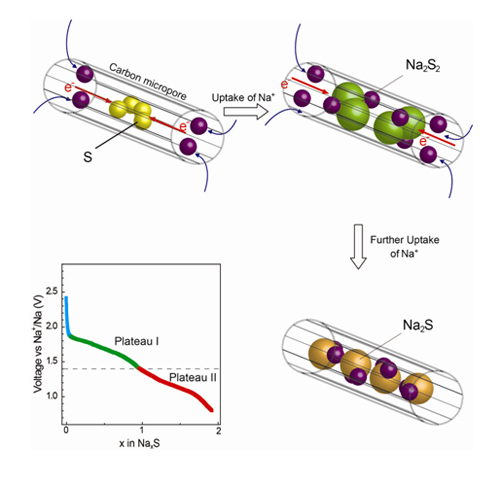Under the supports of the National Natural Science Foundation of China, the Chinese Ministry of Science and Technology, the Chinese Academy of Sciences, Prof. Yu-Guo Guo’s group from the CAS Key Laboratory of Molecular Nanostructure and Nanotechnology made great progress on the development of high-performance sulfur cathode materials by using small sulfur molecules for room-temperature sodium-sulfur batteries. The results have been published as a "Back Cover" article in Adv. Mater. (2014, 26, 1261−1265, Figure 1).
The Na-S battery holds notable advantages, such as high energy density (far exceeding that of the state-of-the-art Li-ion battery) and low material cost (rich abundances of Na and S in nature), making them especially promising for stationary storage applications (e.g., utility-based load-leveling and peak-shaving in smart grid). Traditional Na-S batteries employ sodium β-alumina (NaAl11O17) as the electrolyte, a ceramic able to yield sufficient Na+ conductivity only when the temperature goes beyond 300 ºC. Since the temperatures far exceed the melting points of Na (98 ºC) and S (115 ºC), both electrodes operate in their molten states, making them more reactive and corrosive than solid electrodes, and bringing serious safety concerns. Moreover, a considerable amount of power is consumed to maintain the high working temperature of Na-S battery. Room-temperature Na-S batteries with solid electrodes can offer better durability and improved safety, yet suffer from a low conductivity of sulfur and the formation of electrolyte-soluble polysulfides during the discharge-charge process, leading to limited material utilization and poor cycling performance of the cathode.
The problems in the room-temperature Na-S battery are similar to those in the Li-S battery. To improve the cycling performance of the Li-S battery, Prof. Yu-Guo Guo and his co-workers proposed to diminish the formation of soluble polysulfides (Li2Sn, n = 4-8) by controlling the sulfur as smaller allotropes (Sn, n ≤ 4), In the previous work, they synthesized a sulfur-carbon composite cathode with metastable small sulfur molecules (S2-4) confined in a microporous carbon. Due to the high electrochemical activity of S2-4 and the fine confinement of microporous carbon, the cathode did not involve any polysulfide dissolution during cycling, but exhibited a high lithium electroactivity and a stable cycling ability in a Li-S battery (J. Am. Chem. Soc., 2012, 134, 18510−18513).
Given that the small sulfur molecule cathodes may also bring opportunities to Na-S battery, they designed and realized room-temperature Na-S batteries with them. It is found that the S2-4 cathode exhibits a high electrochemical reactivity with Na, enabling a complete reduction to Na2S at room temperature, and stable cycling ability free of the formation of soluble polysulfides (Figure 2). The sulfur cathode displays a high specific capacity of 1610 mA h g-1 in the room-temperature Na-S battery, tripling that of the high-temperature Na-S batteries (558 mA h g-1), as well as favorable cycling .stability (reversible capacity of 1000 mA h g-1) and high-rate capability (815 mA h g-1 at 2 C). The room-temperature Na-S battery has demonstrated its practicality by holding a long service life of 200 cycles, which is never seen on previously reported room-temperature Na-S batteries. It is also promising by delivering a high specific energy of 955 W h kg-1 upon initial discharge and 750 W h kg-1 in the subsequent cycles, close to the theoretical value (760 W h kg-1) of the high-temperature Na-S battery but with a significant decrease in working temperature to ambient temperature from 300 °C. The strategy is simple, yet effective, and because of its versatility, could also bring insights to those working on the Li-S battery, attract them to the emerging field of RT Na-S battery, and benefit the industry with their understandings and experience gained on the Li-S system. All these will help to make the best of the resource superiority of Na-S batteries and contribute to a better economic sustainability.
Adv. Mater. 2014, 26, 1261−1265

Figure 1 Back cover of the journal showing the work on room-temperature Na-S battery

Figure 2 Electrochemistry of the room-temperature Na-S battery based on small sulfur molecules
